
Back Epitelio pseudoestratificau columnar AN نسيج طلائي عمادي طبقي كاذب Arabic Epiteli columnar pseudostratificat Catalan بافت پوششی مطبق کاذب Persian Épithélium pseudostratifié French Epitelio pseudostratificato Italian 偽重層上皮 Japanese Meerrijig epitheel Dutch Epitélio pseudoestratificado Portuguese Lažno višeslojan epitel Serbo-Croatian
This article needs additional citations for verification. (January 2015) |
| Pseudostratified columnar epithelium | |
|---|---|
 Illustration depicting ciliated pseudostratified columnar epithelium. | |
| Details | |
| Function | Epithelium |
| Identifiers | |
| TH | H2.00.02.0.02021 |
| FMA | 45572 |
| Anatomical terms of microanatomy | |
| This article is part of a series on |
| Epithelia |
|---|
| Squamous epithelial cell |
| Columnar epithelial cell |
| Cuboidal epithelial cell |
| Specialised epithelia |
|
| Other |
Pseudostratified columnar epithelium is a type of epithelium that, though comprising only a single layer of cells, has its cell nuclei positioned in a manner suggestive of stratified columnar epithelium. A stratified epithelium rarely occurs as squamous or cuboidal.
The term pseudostratified is derived from the appearance of this epithelium in the section which conveys the erroneous (pseudo means almost or approaching) impression that there is more than one layer of cells, when in fact this is a true simple epithelium since all the cells rest on the basement membrane. The nuclei of these cells, however, are disposed at different levels, thus creating the illusion of cellular stratification. All cells are not of equal size and not all cells extend to the luminal/apical surface; such cells are capable of cell division providing replacements for cells lost or damaged.
Pseudostratified epithelia function in secretion or absorption. If a specimen looks stratified but has cilia, then it is a pseudostratified ciliated epithelium, since stratified epithelia do not have cilia. Ciliated epithelia are more common and lines the trachea, bronchi. Non-ciliated epithelia lines the larger ducts such as the ducts of parotid glands.